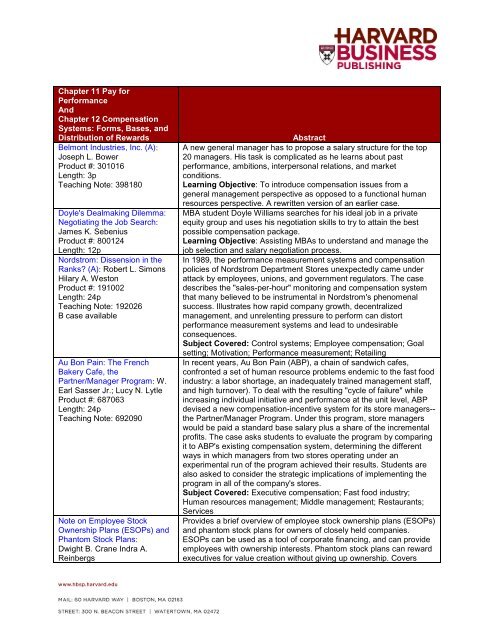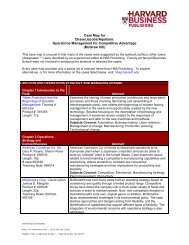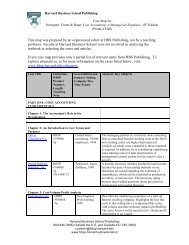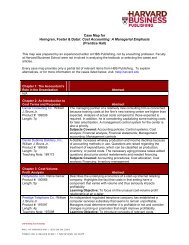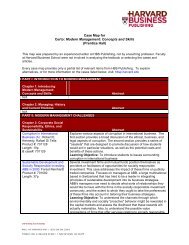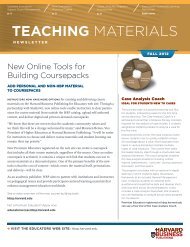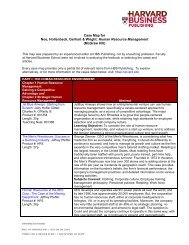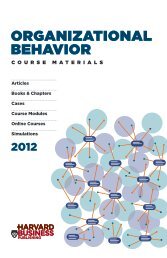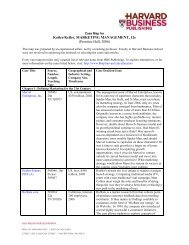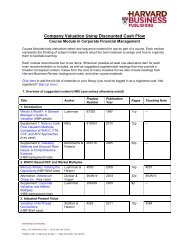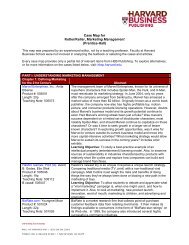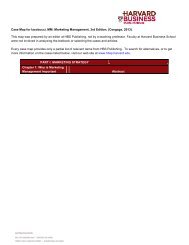Case Map for Baron & Kreps Strategic Human Resources - Harvard ...
Case Map for Baron & Kreps Strategic Human Resources - Harvard ...
Case Map for Baron & Kreps Strategic Human Resources - Harvard ...
Create successful ePaper yourself
Turn your PDF publications into a flip-book with our unique Google optimized e-Paper software.
Chapter 11 Pay <strong>for</strong><br />
Per<strong>for</strong>mance<br />
And<br />
Chapter 12 Compensation<br />
Systems: Forms, Bases, and<br />
Distribution of Rewards<br />
Belmont Industries, Inc. (A):<br />
Joseph L. Bower<br />
Product #: 301016<br />
Length: 3p<br />
Teaching Note: 398180<br />
Doyle's Dealmaking Dilemma:<br />
Negotiating the Job Search:<br />
James K. Sebenius<br />
Product #: 800124<br />
Length: 12p<br />
Nordstrom: Dissension in the<br />
Ranks? (A): Robert L. Simons<br />
Hilary A. Weston<br />
Product #: 191002<br />
Length: 24p<br />
Teaching Note: 192026<br />
B case available<br />
Au Bon Pain: The French<br />
Bakery Cafe, the<br />
Partner/Manager Program: W.<br />
Earl Sasser Jr.; Lucy N. Lytle<br />
Product #: 687063<br />
Length: 24p<br />
Teaching Note: 692090<br />
Note on Employee Stock<br />
Ownership Plans (ESOPs) and<br />
Phantom Stock Plans:<br />
Dwight B. Crane Indra A.<br />
Reinbergs<br />
Abstract<br />
A new general manager has to propose a salary structure <strong>for</strong> the top<br />
20 managers. His task is complicated as he learns about past<br />
per<strong>for</strong>mance, ambitions, interpersonal relations, and market<br />
conditions.<br />
Learning Objective: To introduce compensation issues from a<br />
general management perspective as opposed to a functional human<br />
resources perspective. A rewritten version of an earlier case.<br />
MBA student Doyle Williams searches <strong>for</strong> his ideal job in a private<br />
equity group and uses his negotiation skills to try to attain the best<br />
possible compensation package.<br />
Learning Objective: Assisting MBAs to understand and manage the<br />
job selection and salary negotiation process.<br />
In 1989, the per<strong>for</strong>mance measurement systems and compensation<br />
policies of Nordstrom Department Stores unexpectedly came under<br />
attack by employees, unions, and government regulators. The case<br />
describes the "sales-per-hour" monitoring and compensation system<br />
that many believed to be instrumental in Nordstrom's phenomenal<br />
success. Illustrates how rapid company growth, decentralized<br />
management, and unrelenting pressure to per<strong>for</strong>m can distort<br />
per<strong>for</strong>mance measurement systems and lead to undesirable<br />
consequences.<br />
Subject Covered: Control systems; Employee compensation; Goal<br />
setting; Motivation; Per<strong>for</strong>mance measurement; Retailing<br />
In recent years, Au Bon Pain (ABP), a chain of sandwich cafes,<br />
confronted a set of human resource problems endemic to the fast food<br />
industry: a labor shortage, an inadequately trained management staff,<br />
and high turnover). To deal with the resulting "cycle of failure" while<br />
increasing individual initiative and per<strong>for</strong>mance at the unit level, ABP<br />
devised a new compensation-incentive system <strong>for</strong> its store managersthe<br />
Partner/Manager Program. Under this program, store managers<br />
would be paid a standard base salary plus a share of the incremental<br />
profits. The case asks students to evaluate the program by comparing<br />
it to ABP's existing compensation system, determining the different<br />
ways in which managers from two stores operating under an<br />
experimental run of the program achieved their results. Students are<br />
also asked to consider the strategic implications of implementing the<br />
program in all of the company's stores.<br />
Subject Covered: Executive compensation; Fast food industry;<br />
<strong>Human</strong> resources management; Middle management; Restaurants;<br />
Services<br />
Provides a brief overview of employee stock ownership plans (ESOPs)<br />
and phantom stock plans <strong>for</strong> owners of closely held companies.<br />
ESOPs can be used as a tool of corporate financing, and can provide<br />
employees with ownership interests. Phantom stock plans can reward<br />
executives <strong>for</strong> value creation without giving up ownership. Covers


